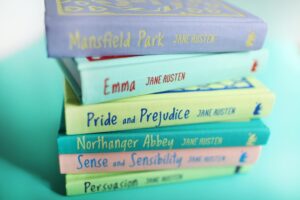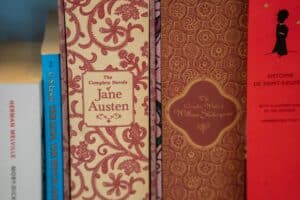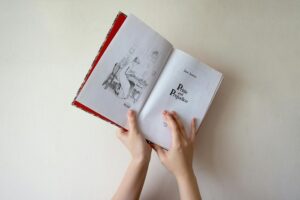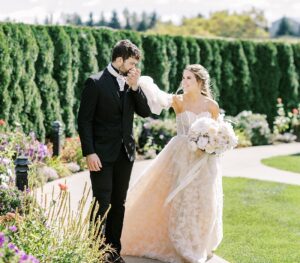Pride and Prejudice as a Study of Human Relations
Jane Austen’s Pride and Prejudice as a study of human relations has its own identity in Enlish literature. The story revolves around families with parents and their children. The story follows the growing up of these children and ends with the heroines finding not just husbands, but their own homes and families. While it may seem like a romance, the focus is on how the experiences shape the heroines, helping them choose the right life partners. For example, Elizabeth Bennet becomes the lady of a rich landowner’s estate.
Austen’s main concern is personal relationships. She explores how these relationships reflect personal morals and the individual’s role in society. Her view aligns with the 18th-century belief that humans are social beings who must fulfill their duties towards others. Even love is seen as a social act that affects not just the couple but their families and society. This is evident in Wickham and Lydia’s elopement, which almost ruins the happiness of Jane and Elizabeth. If the marriage hadn’t been quickly arranged, it could have permanently damaged many lives. Even Mr. Darcy feels responsible and would have been deeply affected.

In contrast, the marriages that conclude the novel—Jane with Bingley and Elizabeth with Darcy—bring happiness and stability. These unions are shown in the context of their families, affecting not just the couple but also characters like Mr. and Mrs. Bennet, Georgiana Darcy, Caroline Bingley, and Lady Catherine. Austen highlights that happy marriages benefit society as a whole.
However, Austen does not suggest that family should always dictate marriage. Darcy marries Elizabeth despite Lady Catherine’s objections. His decision defies convention and proves that marriage should not be based solely on family or societal expectations. Instead, Austen shows a complex view of life. She does not preach to marry for love, family, or society. Rather, she presents individuals dealing with various circumstances, making her work complex and realistic. Austen’s novels provide a vivid sense of life’s intricacies, making them great works of art.
#Pride and Prejudice as a study of human relations #Pride and Prejudice as a study of human relations #Pride and Prejudice as a study of human relations #Pride and Prejudice as a study of human relations #Pride and Prejudice as a study of human relations #Pride and Prejudice as a study of human relations #Pride and Prejudice as a study of human relations #Pride and Prejudice as a study of human relations #Pride and Prejudice as a study of human relations
Related University Questions
- The material of the novelist is the world of human beings and their relations to each other.” Examine Pride and Prejudice in the light of this remark.
- Estimate Pride and Prejudice as a study of human relations in the society of Jane Austen’s time.
- How does Pride and Prejudice reflect the nature of human relationships in Jane Austen’s society?
- Analyze how Jane Austen explores human interactions and social relationships through the characters in Pride and Prejudice.
- In Pride and Prejudice, Jane Austen explores the impact of marriage choices on individuals, families, and society. How does Austen contrast marriages like those of Elizabeth and Darcy with Wickham and Lydia’s, to show the consequences of personal and social responsibilities in human relationships? Discuss how Austen uses these marriages to illustrate her views on family influence and societal expectations.
- In what ways does Pride and Prejudice depict human relations within the societal framework of Austen’s era?
- Discuss how Pride and Prejudice serves as a portrayal of social and personal relationships in the context of 18th-century England.
- Pride and Prejudice presents marriage as both a personal and social institution that affects many lives. Examine how Austen uses the relationships of Elizabeth and Jane Bennet to show that marriage is more than a romantic choice—it’s an act that influences family harmony and social stability. In your answer, consider Austen’s portrayal of duty, moral integrity, and societal pressures in shaping her characters’ choices.
- Examine how Jane Austen uses Pride and Prejudice to illustrate human connections and societal expectations of her time.
- Pride and Prejudice has been celebrated as a profound study of human relationships, showcasing how marriage, family, and societal duties intertwine in shaping individual lives. How does Jane Austen illustrate that the choices of characters, like Elizabeth Bennet and Mr. Darcy, impact not only themselves but also their families and broader society? In your answer, analyze how Austen contrasts the outcomes of various marriages in the novel to reflect her views on social duty, personal integrity, and the balance between individual choice and family expectations.
- Austen’s Pride and Prejudice suggests that individual choices in marriage affect family and society’s well-being. How does Austen contrast Darcy’s socially responsible actions with Wickham’s reckless behavior to reveal her views on the balance between personal freedom and social duty? Provide examples of how Austen illustrates the broader impact of marriage on family relationships and society.
- In Pride and Prejudice, Jane Austen explores marriage as both a reflection of individual character and a significant social responsibility. How does Austen use the outcomes of various marriages to highlight the importance of moral and social considerations in human relationships? Discuss with examples how Austen reveals that fulfilling personal and societal duties contributes to the stability of families and communities.
Read More
Theme of Marriage in Pride and Prejudice
Plot Construction in Pride and Prejudice
Role of Susan in the Tragedy of Henchard
Women in The Mayor of Casterbridge
Renaissance poetry—Age of Rebirth of Arts, Literature and Humanism
Michael Henchard As a Man of Character
Visit Us on our Facebook Page:





